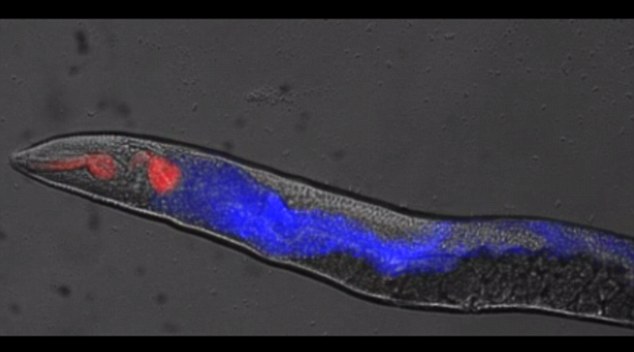Death is a process that eventually comes for all living things – but, just how the body succumbs is not the same for every organism.
In humans, a state known as rigor mortis sets in hours after passing, causing the body to stiffen up before ultimately relaxing again.
But for a species of roundworm, rigor mortis begins while the creature is still alive.
Scientists have captured footage of worms undergoing rigor mortis for the first time, uncovering new insight on the processes that occur as a multicellular organism dies – and, it could reveal clues on age-related death in humans.
According to the researchers from University College London, the discovery marks the first time rigor mortis has been observed in worms.
While death may be defined as the moment the heart ceases to beat or the brain no longer functions, the processes involved may begin long before this.
‘Cell death has been widely studied but much less is known about death of whole organisms, how it happens, what triggers it, and when it begins and ends,’ says Professor David Gems, from UCL Institute of Healthy Ageing.
‘But it’s extremely important for understanding fatal disease in humans, especially those caused by aging.’
In C. elegans, the researchers observed how death spreads through the body in a process known as cellular necrosis.
Beginning the muscle, dying cells trigger the death of their neighbours by releasing calcium.
This leads to hypercontraction and rigor mortis.
Then, death spreads to the intestine.


In C. elegans, the researchers observed how death spreads through the body in a process known as cellular necrosis. Beginning the muscle, dying cells trigger the death of their neighbours by releasing calcium.

In the footage, the researchers use blue fluorescence to highlight the passage, showing how death spreads from cell to cell ‘like a house burning down,’ said lead author Dr Evgeniy Galimov.
According to the team, the rigor mortis seen in the worms is similar to that which occurs in humans, with muscle contraction followed by relaxation.
But, for C. elegans, it happens much earlier.
‘What really surprised us at first was that rigor mortis in worms begins while they are still alive,’ said Dr Galimov.
‘But then we realized that death from circulatory failure, as in mammals, doesn’t happen in C. elegans. The worms are so small they don’t need a circulatory system to get oxygen for respiration.’
The findings suggest old age decline is linked to cells’ weakening ability to generate energy in the form of ATP.
Without this energy, the cells can’t hold calcium in the muscle, causing it to flood out and trigger necrosis.
‘Dying C. elegans also undergo what we term a “belly punch” phenomenon where death contraction in the head drives the pharynx backwards into the intestine, and the impact triggers cell death,’ said Professor Gems.
‘Discovering rigor mortis in worms is exciting as it highlights a key step in the chain of events leading from healthy adulthood to death from old age,’ Gems said.
‘It helps us to understand death in humans, and perhaps in the future to prevent death in mortally ill patients.’













